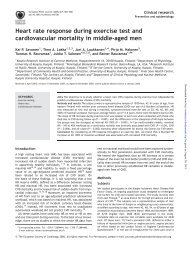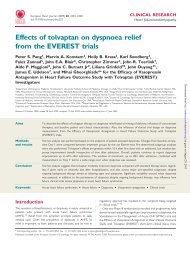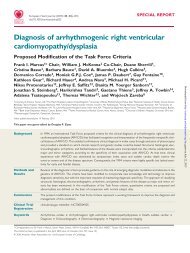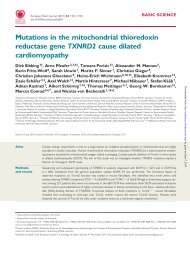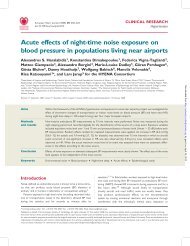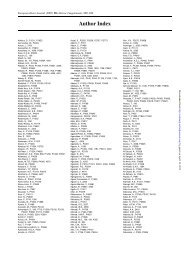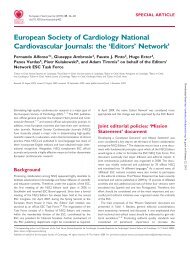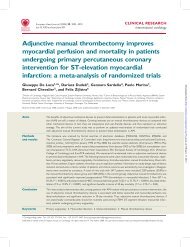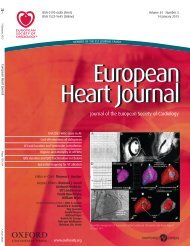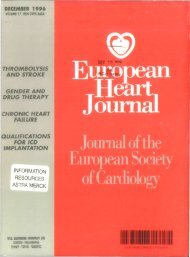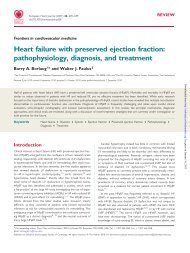Monday, 1 September 2008 - European Heart Journal
Monday, 1 September 2008 - European Heart Journal
Monday, 1 September 2008 - European Heart Journal
You also want an ePaper? Increase the reach of your titles
YUMPU automatically turns print PDFs into web optimized ePapers that Google loves.
298 Perspectives in heart failure treatment<br />
P1945 Intravenous mildronate improves flow-mediated<br />
vasodilatory response in stable chronic heart failure:<br />
double-blind placebo-controlled crossover study<br />
L. Voronkov, I. Shkurat, O. Lutsak. Institute of Cardiology, <strong>Heart</strong><br />
Failure, Kiev, Ukraine<br />
Background: Taking to account recently established independent role of endothelial<br />
dysfunction (ED) in chronic heart failure (CHF) progression and mortality,<br />
normalization of ED may be considered as an important therapeutic goal in<br />
CHF. Mildronate (trimethylhydrazinium propionate dihydrate) is a new, now clinically<br />
tested in stable angina, partial fatty acids oxidation inhibitor with concomitant<br />
experimentally established potent endothelium-mediated vasorelaxation properties.<br />
Objective: To evaluate the ability of mildronate to modulate flow-mediated vasodilatory<br />
response (FMVR) in stable CHF.<br />
Method: 30 pts with stable CHF (NYHA II-III, left ventricular EF ≤ 40%) at<br />
chronic (≥ 2 months) ACE-inhibitor/β-blocker/diuretic therapy were examined. All<br />
pts signed informed consent for the participation in trial. A. brachialis diameter<br />
was detected ultrasonographically at Sonoline Omnia system before (D1) and<br />
after (D2) standard forearm cuff test (200 mm Hg during 5 min). FMVR was calculated<br />
by formula: (D2 – D1)/D1 x 100%. Forearm cuff test also was performed<br />
in 30 healthy age-matched controls. Placebo protocol (PP) was represented by<br />
initial FMVR test (A), 30 min recovery period (B), 100 ml saline (0,85% NaCl)<br />
infusion during 30 min (C), repeated FMVR test 30 min after end of infusion (D).<br />
Points A, B and D of active drug protocol (ADP) were similar to PP; C point was<br />
represented by mildronate 1000 mg infusion in 100 ml of saline during 30 min.<br />
The interval between PP and ADP was 48 hours, at that in one group (15 pts) PP<br />
was performed first and in other group (15 pts) – the ADP first. Neither pts nor<br />
FMVR performer knew about presence/absence of active drug in infused solution.<br />
Groups FMVR, % p A vs B<br />
Baseline (A) After infusion (B)<br />
CHF placebo protocol (I) 9,6±0,7 10,4±0,8 NS<br />
CHF active drug protocol (II) 8,3±0,8 14,4±0,9 < 0,001<br />
Controls 11,1±0,8 –<br />
pIvsII NS < 0,001<br />
p I vs controls < 0,01 –<br />
p II vs contols < 0,001 –<br />
Conclusion: Intravenous mildronate dramatically improves impaired FMVR in<br />
conventionally treated stable CHF patients.<br />
P1946 Influence of regeneration of heart muscle by<br />
intracoronary autologous bone marrow cell<br />
transplantation on the BNP levels in patients with<br />
chronic ischemic heart disease<br />
R. Turan, M. Brehm, M. Koestering, S. Steiner, T. Zeus, T. Bartsch,<br />
S. Yokus, C.M. Schannwell, B.E. Strauer. Heinrich Heine University Duesseldorf,<br />
Cardiology, Pneumology And Angiology, Duesseldorf, Germany<br />
Introduction: We recently demonstrated in patients with chronic myocardial infarction<br />
by intracoronary transplantation of autologous bone marrow mononuclear<br />
cells (BMCs) after 3 months follow-up that the infarct size was reduced by 30%,<br />
whereas the global LV ejection fraction increased by 15% and regional infarct wall<br />
movement velocity by 57%. (The IACT Study)<br />
We analyzed the influence of regeneration of human infarcted heart muscle by<br />
intracoronary cell therapy after 3 months follow up on the BNP levels in PB<br />
Methods and Results: Peripheral blood levels of BNP were measured by BNPassay<br />
in 40 patients with chronic ischemic heart disease pre intracoronary cell<br />
therapy as well as 3 months after intracoronary cell therapy. We showed in patients<br />
with chronic myocardial infarction by intracoronary transplantation of autologous<br />
bone marrow cells (BMC) after 3 months follow up a significant reduced<br />
of infarct size and increase of global LV-ejection fraction as well as infarct wall<br />
movement velocity. Clinically we observed significant improvement in NYHA classification<br />
3 months after intracoronary stem cell therapy as compared to before<br />
(p=0.002). Furthermore we found a significant decrease of the BNP levels in peripheral<br />
blood 3 months after intracoronary stem cell therapy as compared to<br />
before (p=0.002)<br />
Conclusion: Selective intracoronary transplantation of autologous bone marrow<br />
mononuclear cells reduces infarct size and improves LV-Function. In Addition<br />
this intracoronary cell transplantation improves clinical symptoms in patients with<br />
chronic ischemic heart disease<br />
P1947 Clinical effects and safety profile of initial<br />
monotherapy with bisoprolol versus enalapril in<br />
elderly patients with heart failure<br />
D. Dobre 1 , D.J. Van Veldhuisen 1 , M.A. Goulder 2 ,H.Krum 3 ,<br />
R. Willenheimer 4 . 1 University Medical Centre Groningen, Clinical<br />
Pharmacology, Groningen, Netherlands; 2 Nottingham Clinical Research Limited,<br />
Nottingham, United Kingdom; 3 Monash University/Alfred Hospital, Melbourne,<br />
Australia; 4 <strong>Heart</strong> Health Group and Lund University, Cardiology, Malmo, Sweden<br />
Purpose: To assess the clinical effects and safety profile of initial monotherapy<br />
with either bisoprolol or enalapril in elderly patients with heart failure (HF).<br />
Methods: In CIBIS III, 1010 patients with mild to moderate HF, age ≥ 65 years<br />
and left ventricular ejection fraction ≤ 35% were randomized to monotherapy with<br />
bisoprolol or enalapril for 6 months. We evaluated the effect on the combined endpoint<br />
of all-cause mortality or hospitalization, each individual end-point, causes of<br />
death, signs and symptoms of HF, and safety profile. The primary end point of allcause<br />
mortality or hospitalization, and mortality and hospitalizations separately,<br />
were analyzed by Cox proportional hazards model with treatment as the only<br />
independent variable.<br />
Results: Bisoprolol had a similar effect as enalapril regarding the combined endpoint<br />
of all-cause mortality or hospitalization (hazard ratio [HR] 1.02; 95% confidence<br />
interval [CI] 0.78 to 1.33, p=0.90). Slightly fewer patients died on bisoprolol<br />
than on enalapril (23 vs. 32, p=0.24) which was related to the number of sudden<br />
deaths (8 vs. 16; p=0.11). On the other hand, more cases of worsening HF requiring<br />
hospitalization or occurring while in hospital were observed in the bisoprolol<br />
group (HR 1.67; 95% CI 1.04 to 2.70, P=0.03). The two groups were similar with<br />
regard to treatment cessations (7% vs. 10%, p=0.11) and early introduction of the<br />
second drug (8% vs. 7%, p=0.81).<br />
Conclusions: Bisoprolol and enalapril had a similar effect on the combined endpoint<br />
of mortality or hospitalization during 6 months monotherapy. Although a<br />
trend to fewer deaths was observed with bisoprolol, this was offset by more HF<br />
hospitalizations.<br />
P1948 Antithrombotic drugs in patients with chronic heart<br />
failure<br />
M. Lainscak1 , L. Hodoscek-Majc2 , S. Von Haehling3 , W. Doehner3 ,<br />
S.D. Anker 3 . 1University Clinic of Respiratory Diseases, Division<br />
of Cardiology, Golnik, Slovenia; 2General Hospital Murska Sobota,<br />
Department of Internal Medicine, Murska Sobota, Slovenia; 3Charite Campus<br />
Virchow-Klinikum, Division of Applied Cachexia Research, Berlin, Germany<br />
Background: Limited data supports the use of antithrombotic drugs (antiplatelets<br />
and anticoagulants) in patients with chronic heart failure (CHF). According to recent<br />
CHF guidelines, only patients with concomitant atrial fibrillation (AF) could be<br />
treated, whereas AF guidelines suggest risk stratification (e.g. CHADS2 score).<br />
Our aim was to investigate the prevalence and predictors of antithrombotic drugs<br />
prescription in patients with CHF and their prognostic impact.<br />
Methods: In our population based survey, we screened all discharges and deaths<br />
from our community hospital (population 125.000) from 2001 to 2003. We identified<br />
638 patients (73±10 years, 48% men, 74% NYHA class III) who were discharged<br />
alive and had diagnosis of CHF according to ICD 10. Medical charts and<br />
ECG recordings were reviewed in detail, and vital status was obtained from a<br />
Central Population Registry.<br />
Results: AF was present in 330 (52%) patients with CHF, who were older (74±10<br />
vs 72±11 years, p=0.021), had lower eGFR (50±18 vs 53±21 mL/min, p=0.044)<br />
and total cholesterol (4.6±1.6 vs 5.0±1.5 mmol/L, p=0.002) and higher uric acid<br />
(434±145 vs 406±132 mmol/L, p=0.020). At discharge, patients with AF were<br />
prescribed with more optimal treatment: ACE inhibitors (83% vs 75%, p=0.019,<br />
OR 1.60, 95% CI 1.08-2.35), beta-blockers (31% vs 20%, p=0.003, OR 1.71,<br />
95% CI 1.21-2.50), and spironolactone (49% vs 37%, p=0.003, OR 1.63, 95%<br />
CI 1.19-2.24). Overall, antithrombotic drugs and warfarin were prescribed in 430<br />
(67%) and 197 (31%) patients, respectively. CHADS2 score was ≥2 in 85% of<br />
patients with AF. Patients with AF were more likely to receive antithrombotics<br />
(n=274 [83%], OR 4.77, 95% CI 3.31-6.86) and warfarin (n=168 [51%], OR 9.98,<br />
95% CI 6.43-15.48). AF was not associated with higher disk of death (HR 1.13,<br />
95% CI 0.93-1.37). Kaplan-Meier and univariate Cox proportional hazard analysis<br />
showed that use of warfarin (log rank test p=0.0008, HR 0.62, 95%CI 0.47-0.81)<br />
but not of antiplatelet drugs (log rank test, p=0.34, HR 1.16, 95%CI 0.85-1.59)<br />
was associated with reduced mortality in patients with AF. In a Cox proportional<br />
hazard model, adjusted for age, gender, eGFR, total cholesterol, uric acid, and<br />
treatment with ACE inhibitors, beta blockers, and spironolactone, the finding for<br />
warfarin was borderline: HR 0.74, 95% CI 0.53-1.05.<br />
Conclusions: In large unselected cohort of patients with CHF from a community<br />
hospital, AF was very prevalent but it was not predictive of mortality. According to<br />
CHADS2 score, warfarin was underprescribed. Warfarin but not antiplatelet drugs<br />
were associated with better outcome in patients with AF.<br />
Downloaded from<br />
http://eurheartj.oxfordjournals.org/ by guest on December 8, 2012



